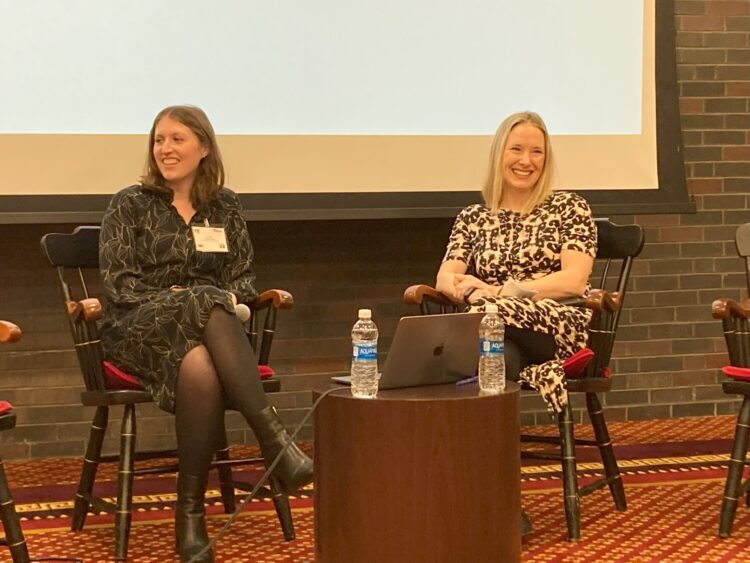It’s a chronic problem with narrative journalism. No matter what media you work in, no matter what genre, no matter whether your deadlines are short and solid or long and adjustable — it never feels like you have enough time to produce the best story.
But consider The Journal., a podcast that tells “the most important stories, explained through the lens of business,” by The Wall Street Journal in partnership with Spotify. The show has aired a narrative every weekday for five years. Even allowing for a bit of time off, that’s roughly 250 stories delivered at a very fast clip. So it’s hard imagine two people with more experience telling stories on a tight deadline than Katherine Brewer, a senior editor at The Journal podcast, and Sarah Platt, the program’s executive producer. The two offered tips for fast-turn stories in a talk at the 2024 Boston University Power of Narrative conference.
First, a caveat: The Journal. team includes several producers and works on multiple stories at a time. But they have created episodes in mere hours and rarely spend more than a few days on a single story from start to finish. The narratives are always built from a strong news hook and rooted in a keen knowledge of narrative structure. Here’s the core process:
- Find a character. In news-driven stories like the ones told on The Journal., you are really telling two stories, or two focused parts of the same story, Brewer said. The first is the traditional news story, such as echnical and business reasons that iPhones and Android phones are incompatible. The second is the story of your character. In one episode of The Journal., for example, the main character was a man couldn’t join his in-laws’ family group chats because he is an Android user and they use iPhones. In other shows, the character may be competing sides of a lawsuit, or a high-level company official or a well-known person in the business world, such as Elon Musk or Sam Altman.
- Create a timeline. “Chronology is the fastest way to narrative,” Brewer said. That doesn’t mean you have to tell your story chronologically, but a timeline helps you determine where to start, and where find the beginning, middle and end of your story.
- Use a three-act structure. Act one is the set up. Act two is confrontation. Act three is the resolution. “You can scramble those,” Brewer said, “but if you don’t have those pieces somewhere, then you probably need to re-think your narrative.”
- Know your driving question. “Reality TV is good at ‘driving questions,’” Platt said. (Example: Who will be voted off the island tonight?) Platt played a clip from an episode of The Journal. featuring a woman whose car keeps getting stolen. The driving question of that story: Why are Kias and Hyundais being stolen in record numbers? “It sets up the stakes for the character, but also for the car companies,” Platt said. While some journalists think of this as the thesis, The Journal. team likes to build stories around a strong, driving question, which then threads through the three-act structure. In the first act, a question is raised; in act two, the question is explored; and in act three, it is answered. Platt warns against building a story around a driving question that is not answerable: “That is almost always a mistake.”
- It has to mean something. While a news story can end with what’s happening next, a good narrative needs to reveal something about the world, Platt said. The answer to your driving question is what provides that meaning. This can be difficult, but small moments can be profound. The pair used an example from a story about gambling addiction. When the main character walked into her first Gamblers Anonymous meeting, the room was full and she realized that what had happened to her could happen to anybody. That small moment contained a profound realization.
- Stay focused. Keeping focused on the story in progress and the process of producing it helps The Journal team work efficiently. The editor and producers ask direct, specific questions of rpeorters and don’t allow tangents. “Know your driving question, know what you want your timeline to be, and stay within the walls of that,” Brewer said. That discipline of focus allowed The Journal. to post an episode on the day-long January 6, 2021, Capitol attack that same evening. It remains one of The Journal’s most-downloaded episodes.
* * *
Madeline Bodin is a freelance environmental and science journalist who is based in Vermont.



